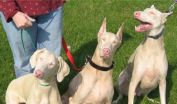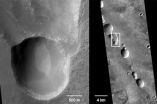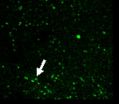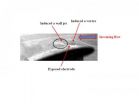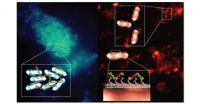(Press-News.org) Michigan State University researchers have identified a genetic mutation in Doberman pinschers that causes albinism in the breed, a discovery that has eluded veterinarians and breeders worldwide up until now.
Paige Winkler, a doctoral student in the College of Veterinary Medicine, co-led the study with Joshua Bartoe, an assistant professor in the Department of Small Animal Clinical Sciences, and discovered a mutated gene that is associated with a form of albinism in humans.
"What we found was a gene mutation that results in a missing protein necessary for cells to be pigmented," said Winkler. "Some defects in this same gene cause a condition called oculocutaneous albinism in humans."
This type of albinism has certain characteristics that are evident in both humans and dogs.
"With an albino Doberman, you see a white or lighter-colored coat, pink noses and lips, along with pale irises in the eyes," said Winkler. "These traits are very similar to the characteristics humans display with this particular condition causing light-pigmented skin and hair, along with eye discoloration and vision disturbances."
The canine breed and people also experience the same skin sensitivity to sunlight, which results in an increased risk of skin tumors.
"We knew that the albino Dobermans typically developed these types of tumors, much like humans, but we wondered what the actual increase in prevalence was between a 'white' dog and a regular-colored Doberman," said Bartoe. "What we found was a significant increase in risk for development of melanoma-like tumors in the albino dogs."
Bartoe and Winkler studied 20 dogs of each color and discovered that more than half of the albino dogs had at least one tumor while only one of the regular-colored dogs possessed a tumor.
The results of their research could be of great importance to Doberman breeders around the world. Currently, American Kennel Club registration restricts dogs with the condition.
"Because Dobermans can carry the defective gene, but show no signs of the disorder, this has posed serious problems among breeders," said Bartoe. "But now that we've identified the mutation, we can look at the genetic makeup of these dogs and determine if they might be carriers."
The study can be found in PLOS ONE.
INFORMATION:
Michigan State University has been working to advance the common good in uncommon ways for more than 150 years. One of the top research universities in the world, MSU focuses its vast resources on creating solutions to some of the world's most pressing challenges, while providing life-changing opportunities to a diverse and inclusive academic community through more than 200 programs of study in 17 degree-granting colleges.
Man's best friend shares similar 'albino' gene
2014-05-12
ELSE PRESS RELEASES FROM THIS DATE:
Against the current with lava flows
2014-05-12
This news release is available in German.
An Italian astronomer in the 19th century first described them as 'canali' – on Mars' equatorial region, a conspicuous net-like system of deep gorges known as the Noctis Labyrinthus is clearly visible. The gorge system, in turn, leads into another massive canyon, the Valles Marineris, which is 4,000 km long, 200 km wide and 7 km deep. Both of these together would span the US completely from east to west.
As these gorges, when observed from orbit, resemble terrestrial canyons formed by water, most researchers assumed that ...
Drug therapy for allergy moves forward
2014-05-12
Researchers have identified several target molecules which are suitable for the development of new allergy drugs. The Journal of Allergy and Clinical Immunology, the most prestigious journal in the field of allergology, has recently published an extensive review article on the prospects of drug therapy for allergy. Completed in a large-scale EU project, the lead author of the review article is Professor Ilkka Harvima of the University of Eastern Finland and Kuopio University Hospital.
Immediate allergic reactions and allergic diseases such as allergic rhinitis, asthma ...
Role of pro-urokinase in neuronal apoptosis and revascularization after ACI
2014-05-12
Among the drugs used for acute ischemic stroke, recombinant tissue plasminogen activator is widely accepted internationally. In China, urokinase has been widely used for thrombolysis after acute ischemic stroke. Pro-urokinase is the precursor of urokinase. Compared with urokinase, pro-urokinase has greater ability to dissolve thrombus and is safer to use. However, most countries do not recognize urokinase for thrombolytic treatment after acute ischemic stroke, which has not been approved for clinical use. Dr. Wenli Hu and team from Beijing Chao-Yang Hospital, Capital Medical ...
Unusual neural connection between injured cingulum and brainstem in a SAH patients
2014-05-12
The cingulum is an important pathway for cholinergic innervation for the cerebral cortex. Many studies have reported connections between the cholinergic nuclei, especially between the cholinergic nuclei in the basal forebrain and those in the brainstem via the fornix and thalamus. However, little is known about the connection between cholinergic nuclei in the basal forebrain and cholinergic nuclei in the brainstem via the cingulum. Even no study on this phenomenon after cerebral hemorrhage has been reported. Dr. Sung Ho Jang and team from College of Medicine, Yeungnam University ...
Molecular regulation of hypoxic-ischemic brain damage
2014-05-12
Oligodendrocyte lineage gene 1 (Olig1) plays a key role in hypoxic-ischemic brain damage and myelin repair. miRNA-9 is involved in the occurrence of many related neurological disorders. Bioinformatics analysis demonstrated that miRNA-9 complementarily, but incompletely, bound oligodendrocyte lineage gene 1, but whether miRNA-9 regulates oligodendrocyte lineage gene 1 remains poorly understood. Dr. Lijun Yang and co-workers from Beijing Friendship Hospital, Capital Medical University in China prepared whole brain slices from a rat model of oxygen-glucose deprivation and ...
Unmanned air vehicle flow separation control using dielectric barrier discharge plasma at high wind
2014-05-12
Plasma technology based on Dielectric Barrier Discharge (DBD) has been widely demonstrated to be a novel active flow control method. In order to make the plasma flow control technology more practical, the plasma authority must be improved at high wind speed. Dr. ZHANG Xin and his group from School of Aeronautic, Northwestern Polytechnical University set out to tackle this problem. After 2-years of innovative research, they have developed a novel plasma actuator to improve the plasma authority at high wind speed. They found that the novel plasma actuator acting on the surface ...
Dopamine turns worker ants into warrior queens
2014-05-12
VIDEO:
When an H. saltator colony's queen dies, the female workers engage in ritual fights to establish dominance. Ultimately, a small group of workers establishes dominance and become a cadre of...
Click here for more information.
The ritualized fighting behavior of one ant species is linked to increases in dopamine levels that trigger dramatic physical changes in the ants without affecting their DNA, according to research from North Carolina State University, Arizona State ...
Major breakthrough in understanding Prader-Willi Syndrome, a parental imprinting disorder
2014-05-12
Scientists at the Hebrew University of Jerusalem have reported a major breakthrough in understanding the molecular basis for Prader-Willi syndrome (PWS), perhaps the most studied among the class of diseases that involves defects in parental imprinting.
The work, described in the latest online edition of the prestigious journal Nature Genetics, was led by Prof. Nissim Benvenisty, the Herbert Cohn Professor of Cancer Research and director of the Stem Cell Unit at the Alexander Silberman Institute of Life Sciences at the Hebrew University; and his PhD student Yonatan Stelzer. ...
Hijacking bacteria's natural defenses to trap and reveal pathogens
2014-05-12
The breakthrough, published in the journal Nature Materials, could offer an easier way of detecting pathogenic bacteria outside of a clinical setting and could be particularly important for the developing world, where access to more sophisticated laboratory techniques is often limited.
The research was led by Professor Cameron Alexander, Head of the Division of Drug Delivery and Tissue Engineering and EPSRC Leadership Fellow in the University's School of Pharmacy, building on work by PhD student Peter Magennis. Professor Alexander said: "Essentially, we have hijacked ...
Revealed:Protein's role in preventing heart muscle growth leading to heart failure
2014-05-12
Cardiovascular disease remains the number one cause of death in the Western world, with heart failure representing the fastest-growing subclass over the past decade. The stage that precedes heart failure in a significant number of cardiovascular diseases is pathological hypertrophy — the growth of the heart muscle in an attempt to increase its output.
Not all hypertrophy is pathological; for example, during pregnancy or high physical exertion, the muscle of the heart grows but myocardial function remains normal. But when hypertrophy is excessive, prolonged and unbalanced, ...
